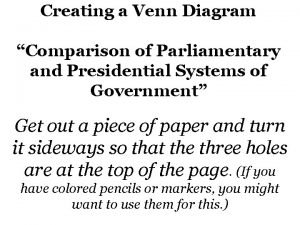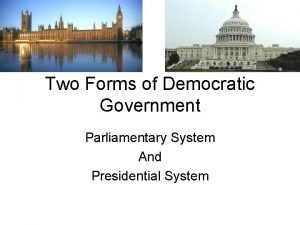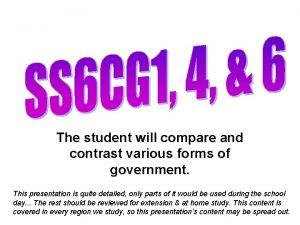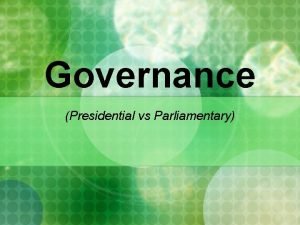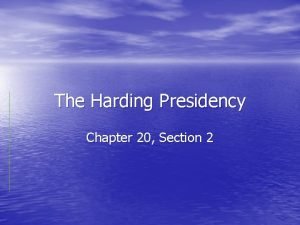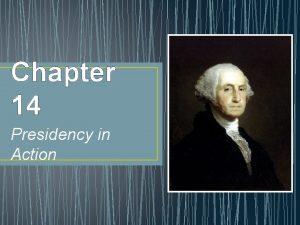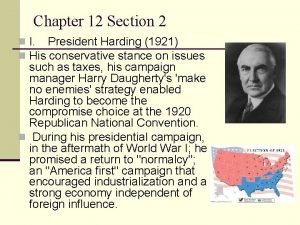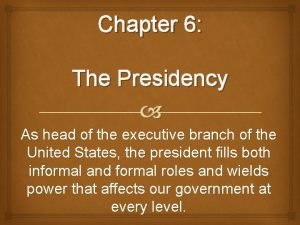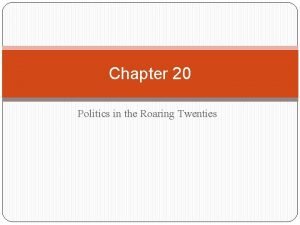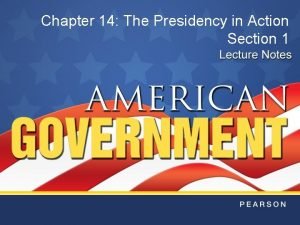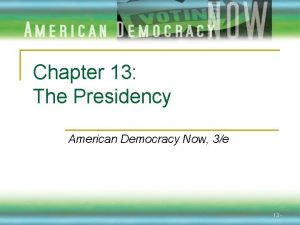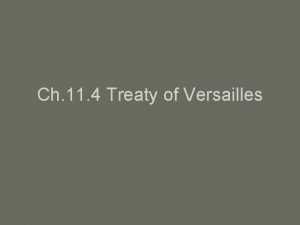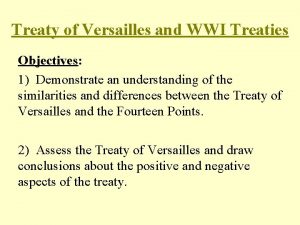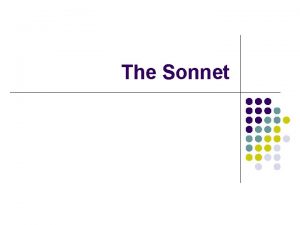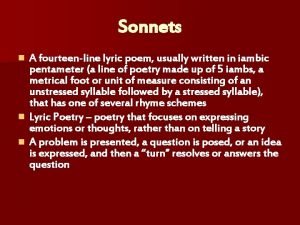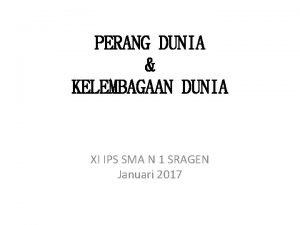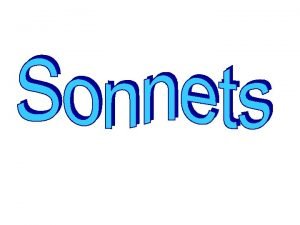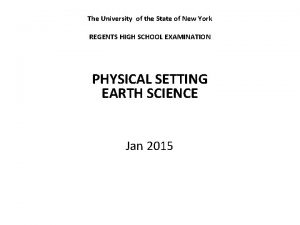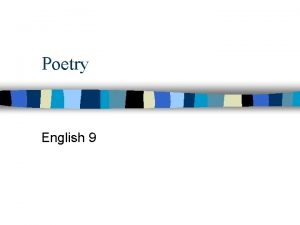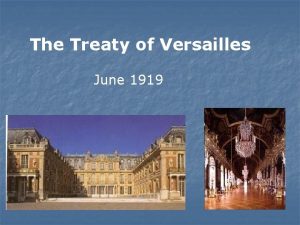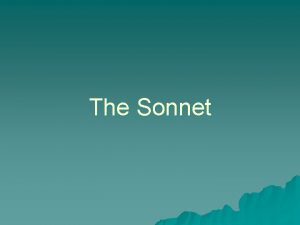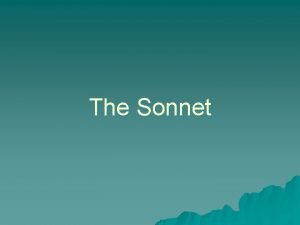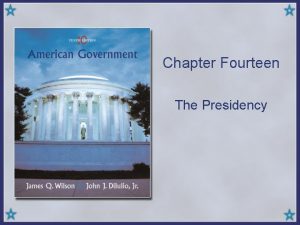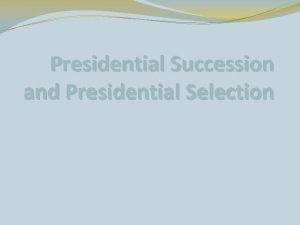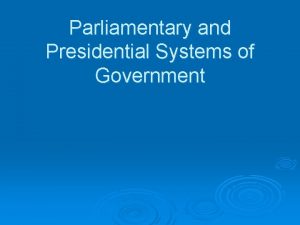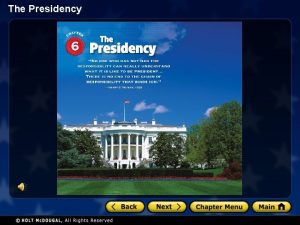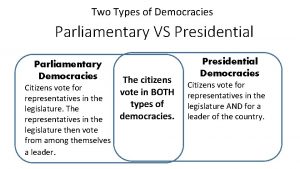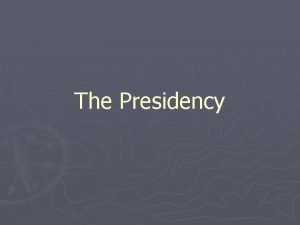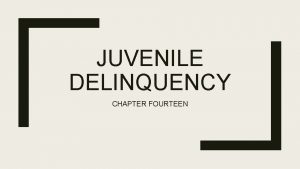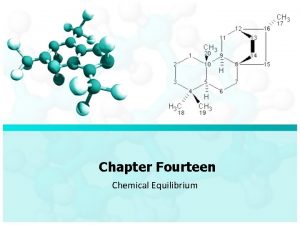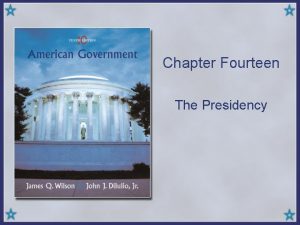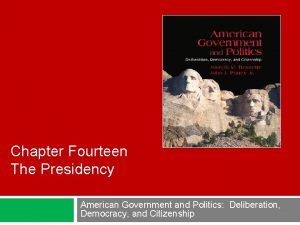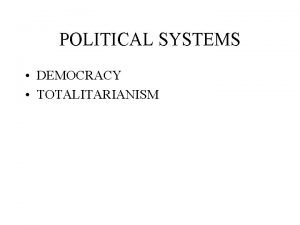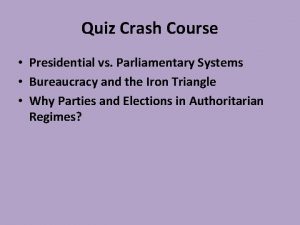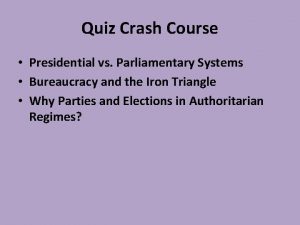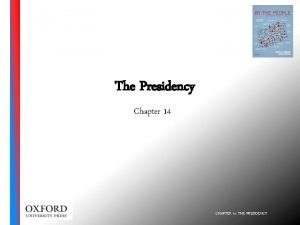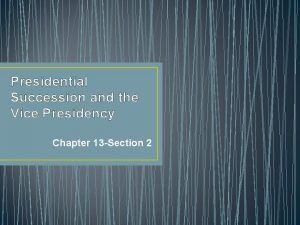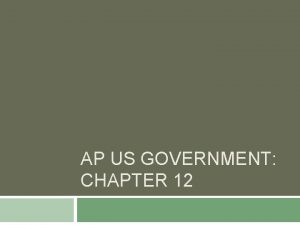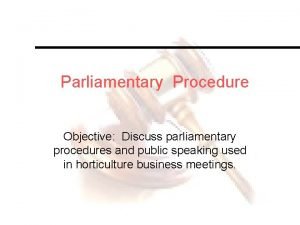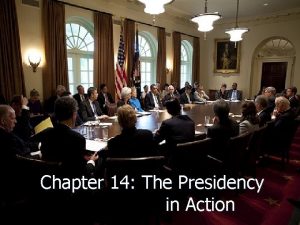Chapter Fourteen The Presidency Presidential and Parliamentary Systems























- Slides: 23

Chapter Fourteen The Presidency

Presidential and Parliamentary Systems • Presidents may be outsiders; prime ministers are always insiders, chosen by the members of the majority party in parliament • Presidents have no guaranteed majority in the legislature; prime ministers always have a majority • Divided government: one party controls the White House and another controls one or both houses of Congress Copyright © Houghton Mifflin Company. All rights reserved. 14 | 2

Electoral College • Almost all states use a winner-take-all system • If no candidate won a majority, the House would decide the election • The Electoral College ultimately worked differently than expected, because the Founders did not anticipate the role of political parties Copyright © Houghton Mifflin Company. All rights reserved. 14 | 3

The First Presidents • The office was legitimated by men active in independence and Founding politics • Minimal activism of early government contributed to lessening the fear of the presidency • Relations with Congress were reserved: few vetoes; no advice from Congress to the president Copyright © Houghton Mifflin Company. All rights reserved. 14 | 4

Powers of the President • Potential for power found in ambiguous clauses of the Constitution—e. g. , power as commander in chief, duty to “take care that laws be faithfully executed” (executive power) • Greatest source of power lies in politics and public opinion Copyright © Houghton Mifflin Company. All rights reserved. 14 | 5

The Power to Persuade • Presidents try to transform popularity into congressional support for their programs • Presidential coattails have had a declining effect for years • Popularity is affected by factors beyond anyone’s control – consider Bush’s approval ratings following the September 11 th attacks Copyright © Houghton Mifflin Company. All rights reserved. 14 | 6

Figure 14. 2: Presidential Popularity Thomas E. Cronin, The State of the Presidency (Boston: Little, Brown, 1975), 110 -111. Copyright © 1975 by Little, Brown and Company, Inc. Reprinted by permission. Updated with Gallup poll data, 1976 -2004. Reprinted by permission of the Gallup Poll News Service. Copyright © Houghton Mifflin Company. All rights reserved. 14 | 7

Figure 14. 2: Presidential Popularity Thomas E. Cronin, The State of the Presidency (Boston: Little, Brown, 1975), 110 -111. Copyright © 1975 by Little, Brown and Company, Inc. Reprinted by permission. Updated with Gallup poll data, 1976 -2004. Reprinted by permission of the Gallup Poll News Service. Copyright © Houghton Mifflin Company. All rights reserved. 14 | 8

Figure 14. 3: Presidential Victories on Votes in Congress, 1953 -2002 Copyright © Houghton Mifflin Company. All rights reserved. 14 | 9

White House Office • Rule of propinquity: power is wielded by people who are in the room when a decision is made • Pyramid structure: most assistants report through hierarchy to chief of staff, who then reports to president – Eisenhower, Nixon, Reagan, Bush, Clinton (late in his administration) Copyright © Houghton Mifflin Company. All rights reserved. 14 | 10

White House Office • Circular structure: cabinet secretaries and assistants report directly to the president – Carter (early in his administration) • Ad hoc structure: task forces, committees, and informal groups deal directly with president – Clinton (early in his administration) Copyright © Houghton Mifflin Company. All rights reserved. 14 | 11

Figure 14. 1: Growth of the White House Staff, 1945 -2002 Harold W. Stanley and Richard G. Niemi, Vital Statistics on American Politics, 2003 -2004 (Washington, D. C. : Congressional Quarterly Press, 2003), 254 -255. Copyright © Houghton Mifflin Company. All rights reserved. 14 | 12

The Cabinet • Not explicitly mentioned in Constitution • Presidents have many more appointments to make than do prime ministers, due to competition created by the separation of power • Presidential control over departments remains uncertain—secretaries become advocates for their departments Copyright © Houghton Mifflin Company. All rights reserved. 14 | 13

Table 14. 1: The Cabinet Departments Copyright © Houghton Mifflin Company. All rights reserved. 14 | 14

Presidential Character • Kennedy: bold, articulate, amusing leader; improviser who bypassed traditional lines of authority • Nixon: expertise in foreign policy; disliked personal confrontation; tried to centralize power in the White House Copyright © Houghton Mifflin Company. All rights reserved. 14 | 15

Presidential Character • Reagan: set policy priorities and then gave staff wide latitude; leader of public opinion • Clinton: good communicator; pursued liberal/centrist policies • George W. Bush: tightly run White House; agenda became dominated by foreign affairs following the September 11 th attacks Copyright © Houghton Mifflin Company. All rights reserved. 14 | 16

The Veto Power • Veto message sent within ten days of the bill’s passage • Pocket veto (only before Congress adjourns at the end of its second session) • Congress rarely overrides vetoes • President does not hold line-item veto power Copyright © Houghton Mifflin Company. All rights reserved. 14 | 17

The President’s Program • Resources in developing a program include interest groups, aides and campaign advisers, federal departments and agencies, and various specialists • Constraints include public and congressional reactions, limited time and attention, and unexpected crises Copyright © Houghton Mifflin Company. All rights reserved. 14 | 18

Presidential Transition • Only fourteen of forty-one presidents have served two full terms (George W. Bush will be the 15 th if he finishes his full 2 nd term) • Eight vice presidents have taken office upon the president’s death Copyright © Houghton Mifflin Company. All rights reserved. 14 | 19

The Vice President • Prior to 2000, only five vice presidents won the presidency in an election without having first entered the office as a result of their president’s death • The vice president presides over Senate and votes in case of tie Copyright © Houghton Mifflin Company. All rights reserved. 14 | 20

The 25 th Amendment (1967) • Allows vice president to serve as acting president if president is disabled • Illness is decided by president, by vice president and cabinet, or by two-thirds vote of Congress • The new vice president must be confirmed by a majority vote of both houses Copyright © Houghton Mifflin Company. All rights reserved. 14 | 21

Impeachment • Indictment by the House, conviction by the Senate • Presidential examples: Andrew Johnson, Richard Nixon (pre-empted by resignation), Bill Clinton • Neither Johnson nor Clinton was convicted by the Senate Copyright © Houghton Mifflin Company. All rights reserved. 14 | 22

Constraints on the President • Both the president and the Congress are more constrained today due to: – Complexity of issues – Scrutiny of the media – Greater number and power of interest groups Copyright © Houghton Mifflin Company. All rights reserved. 14 | 23
 Presidential and parliamentary venn diagram
Presidential and parliamentary venn diagram Different between parliamentary and presidential
Different between parliamentary and presidential Unitary form
Unitary form Presidential vs parliamentary
Presidential vs parliamentary Chapter 20 section 2 the harding presidency
Chapter 20 section 2 the harding presidency President appointment power
President appointment power Chapter 6 section 1 the presidency
Chapter 6 section 1 the presidency Chapter 12 section 2 the harding presidency
Chapter 12 section 2 the harding presidency Unwritten qualifications for president
Unwritten qualifications for president Chapter 20 section 2 the harding presidency
Chapter 20 section 2 the harding presidency Chapter 14 the presidency in action
Chapter 14 the presidency in action American democracy now 5th edition
American democracy now 5th edition Treaty of versailles vs wilson's 14 points
Treaty of versailles vs wilson's 14 points Fourteen points and treaty of versailles similarities
Fourteen points and treaty of versailles similarities It is a fourteen-line poem
It is a fourteen-line poem A 14 line lyric poem written in iambic pentameter
A 14 line lyric poem written in iambic pentameter One two three four five six to hundred
One two three four five six to hundred Perang dunia dan kelembagaan dunia
Perang dunia dan kelembagaan dunia Octave and sestet are the parts of
Octave and sestet are the parts of Fourteen billion years represents the approximate age of
Fourteen billion years represents the approximate age of A fourteen line poem with prescribed rhyme of scheme
A fourteen line poem with prescribed rhyme of scheme Siya ang may akda ng fourteen points
Siya ang may akda ng fourteen points Fourteen line lyric poem
Fourteen line lyric poem Fourteen line lyric poem
Fourteen line lyric poem
